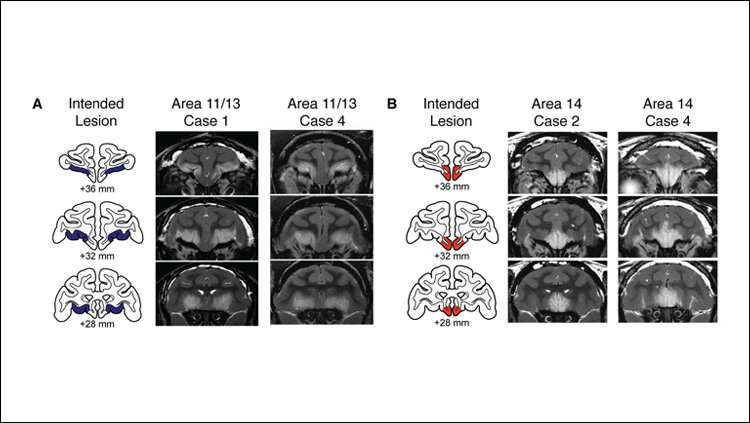Excitotoxic lesions of lateral OFC (lOFC) area 11/13 (A) and medial OFC (mOFC) area 14 (B). The left column in each panel shows the extent of the intended lesion area (lOFC in blue; mOFC in red) on standard coronal sections through the frontal lobe of a macaque brain 36-28 mm rostral to the interaural plane. The middle and right columns in each panel show coronal images at corresponding levels taken from T2-weighted MRI scans obtained within 1 week of surgery from cases 1 and 4 from the lOFC group and cases 2 and 4 from the mOFC group. White hypersignal is associated with edema that follows injections of the excitotoxin ibotenic acid and typically corresponds to the extent of the lesion. Credit: Pujara et al., JNeurosci (2019)
Damage to parts of the orbitofrontal cortex (OFC), a region within the prefrontal cortex, heightens monkeys' defensive responses to threat, according to new research published in JNeurosci. The study proposes a critical role for subregions of this brain area in different anxiety disorders.
A network of brain regions including the OFC has been implicated in human anxiety disorders. For example, previous research has linked arachnophobia and generalized anxiety disorder to decreased activity in lateral and medial OFC, respectively. Elisabeth Murray and colleagues from the National Institute of Mental Health and Icahn School of Medicine at Mount Sinai investigated the role of these OFC subregions in male rhesus macaques trained to retrieve a fruit snack reward in the presence of one of two fake, rubber predators—a grayish-green snake or a black, hairy spider—or neutral objects.
After producing selective lesions in the lateral or medial OFC in eight monkeys, the researchers observed that these animals took longer to reach for the fruit snack in the presence of the predator stimuli compared to 12 animals with intact OFC. The researchers also found that this effect could be attributed to the heightened defensive and reduced approach behaviors that followed damage to either subregion of OFC.
Both experimental groups also failed to reduce their defensive responses to the snake and spider over time.
Finally, monkeys with medial OFC lesions showed a greater tendency to express defensive behaviors even in the absence of threat. Overall, these findings suggest that specific symptoms of various anxiety disorders may arise from dysfunction in distinct subregions of OFC.
More information: Heightened Defensive Responses Following Subtotal Lesions of Macaque Orbitofrontal Cortex, JNeurosci (2019). DOI: 10.1523/JNEUROSCI.2812-18.2019
Journal information: Journal of Neuroscience
Provided by Society for Neuroscience























